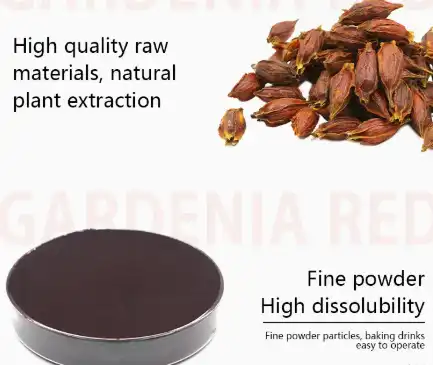
What are the health benefits of using Gardenia Red Powder as a food colorant?
Gardenia Red Powder offers several health benefits that set it apart from other natural food colorants. One of the primary advantages is its high content of antioxidants, particularly crocin and crocetin. These compounds have been shown to have numerous positive effects on human health, including:
- Anti-inflammatory properties: Crocin and crocetin have demonstrated potent anti-inflammatory effects in various studies. This can be beneficial for individuals with chronic inflammatory conditions or those looking to reduce overall inflammation in their bodies.
- Neuroprotective effects: Research suggests that the antioxidants in Gardenia Red Powder may help protect brain cells from oxidative stress and damage. This could potentially contribute to improved cognitive function and a reduced risk of neurodegenerative diseases.
- Cardiovascular health: Some studies have indicated that the compounds found in Gardenia Red Powder may help lower cholesterol levels and improve overall heart health.
- Potential anti-cancer properties: While more research is needed, preliminary studies have shown that crocin and crocetin may have anti-tumor effects and could potentially inhibit the growth of certain cancer cells.
In addition to these specific health benefits, Gardenia Red Powder is also appreciated for its natural origin. As consumers become increasingly conscious of the ingredients in their food, many are seeking natural alternatives to synthetic food colorants. Gardenia Red Powder provides a clean-label solution that aligns with this growing demand for natural and healthier food options.
Furthermore, Gardenia Red Powder is free from common allergens and is suitable for a wide range of dietary restrictions. It's naturally gluten-free, vegan, and kosher, making it an inclusive choice for food manufacturers catering to diverse consumer needs.
It's worth noting that while Gardenia Red Powder offers these potential health benefits, it's important to consider it as part of a balanced diet and healthy lifestyle. The colorant itself is typically used in small quantities in food products, so while it may contribute to overall health, it should not be relied upon as a primary source of these benefits.
How does the stability of Gardenia Red Powder compare to other natural food colorants?
The stability of food colorants is a crucial factor in their effectiveness and usability in various food applications. Gardenia Red Powder stands out in this aspect, offering superior stability compared to many other natural food colorants. This enhanced stability contributes to its growing popularity in the food industry.
One of the key advantages of Gardenia Red Powder is its excellent heat stability. Many natural food colorants, such as anthocyanins from berries or betanin from beetroot, are notoriously sensitive to high temperatures. They often degrade or change color when exposed to heat during food processing or cooking. In contrast, Gardenia Red Powder maintains its vibrant red hue even under high-temperature conditions. This makes it particularly suitable for use in baked goods, confectionery, and other products that undergo heat treatment during production.
Gardenia Red Powder also demonstrates good stability across a wide pH range. Many natural colorants are pH-sensitive, changing color or losing intensity in acidic or alkaline environments. The stability of Gardenia Red Powder across different pH levels allows for its use in a variety of food matrices, from acidic beverages to neutral baked goods.
Light stability is another area where Gardenia Red Powder outperforms many of its natural counterparts. Some natural colorants, particularly those derived from fruits and vegetables, are prone to fading when exposed to light. This can be problematic for products with transparent packaging or those displayed under bright retail lighting. Gardenia Red Powder exhibits better resistance to light-induced fading, helping to maintain the visual appeal of colored products over time.
The oxidative stability of Gardenia Red Powder is also noteworthy. Many natural colorants are susceptible to oxidation, which can lead to color loss or changes in hue. Gardenia Red Powder's resistance to oxidation helps preserve its color integrity during storage and throughout a product's shelf life.
It's important to note that while Gardenia Red Powder offers improved stability compared to many other natural colorants, it's not completely impervious to all environmental factors. Proper formulation, storage, and packaging are still essential to maximize its performance and longevity in food applications.
The enhanced stability of Gardenia Red Powder translates to several practical benefits for food manufacturers:
- Longer shelf life for colored products
- Reduced need for over-coloring to compensate for degradation
- Greater flexibility in processing and formulation
- Improved consistency in color across different batches and products
- Potential for cost savings due to reduced waste and reformulation needs
These stability advantages, combined with its natural origin and potential health benefits, make Gardenia Red Powder an attractive option for food manufacturers looking to create visually appealing, stable, and clean-label products.
What types of food products are best suited for coloring with Gardenia Red Powder?
Gardenia Red Powder's unique properties make it suitable for a wide range of food applications. Its versatility allows food manufacturers to incorporate this natural colorant into various products, creating visually appealing and potentially healthier alternatives to synthetic color additives. Let's explore some of the food categories where Gardenia Red Powder excels:
- Confectionery: The vibrant red hue of Gardenia Red Powder makes it an excellent choice for candies, gummies, and other sweet treats. Its heat stability ensures that the color remains intact during the cooking and molding processes often used in confectionery production.
- Baked Goods: Thanks to its heat resistance, Gardenia Red Powder is well-suited for use in baked products such as cakes, cookies, and pastries. It can provide a consistent red color that doesn't fade or change during baking.
- Beverages: The pH stability of Gardenia Red Powder makes it suitable for both acidic and neutral beverages. It can be used in fruit juices, soft drinks, and even alcoholic beverages to impart a natural red color.
- Dairy Products: Gardenia Red Powder can be incorporated into various dairy products, including yogurt, ice cream, and flavored milk. Its stability in different pH environments makes it compatible with the acidic nature of many dairy products.
- Processed Meats: While not as common, Gardenia Red Powder can be used to enhance the color of certain processed meat products, providing a natural alternative to synthetic red colorants often used in this industry.
- Sauces and Condiments: The colorant can be used in a variety of sauces, dressings, and condiments to provide an attractive red hue without altering the flavor profile significantly.
- Snack Foods: Gardenia Red Powder can be applied to various snack foods, including chips, crackers, and extruded snacks, to create visually appealing products.
- Functional Foods and Supplements: Given its potential health benefits, Gardenia Red Powder is increasingly being used in functional foods and dietary supplements, where it serves both as a colorant and a potentially beneficial ingredient.
When incorporating Gardenia Red Powder into food products, manufacturers need to consider several factors to optimize its performance:
- Dosage: The amount of Gardenia Red Powder needed can vary depending on the desired color intensity and the specific food matrix. Proper dosage trials are essential to achieve the optimal color without affecting taste or texture.
- Solubility: While Gardenia Red Powder is water-soluble, its solubility can be affected by factors such as temperature and pH. Proper dispersion techniques may be necessary to ensure even color distribution in certain applications.
- Interactions: Although generally stable, Gardenia Red Powder may interact with certain ingredients in complex food systems. It's important to test for any potential interactions that could affect color, stability, or overall product quality.
- Regulatory Compliance: While Gardenia Red Powder is considered a natural colorant, it's crucial to ensure compliance with local food regulations and labeling requirements in different markets.
The versatility of Gardenia Red Powder, combined with its stability and potential health benefits, makes it an attractive option for food manufacturers looking to create clean-label, visually appealing products across various food categories. As consumer demand for natural ingredients continues to grow, Gardenia Red Powder is likely to find even more applications in the food industry, offering a sustainable and health-conscious alternative to synthetic red colorants.
Conclusion
Gardenia Red Powder stands out as a unique and versatile natural food colorant, offering several advantages over other options in the market. Its superior stability across various conditions, potential health benefits, and wide range of applications make it an attractive choice for food manufacturers and consumers alike. As the demand for clean-label and natural products continues to grow, Gardenia Red Powder is well-positioned to play an increasingly important role in the food industry, providing a vibrant, stable, and potentially beneficial coloring solution for a diverse array of food products.
If you are also interested in this product and want to know more product details, or want to know about other related products, please feel free to contact lea_slsbio@163.com,WhatsApp+86 13193326505.

References
1. Ng, T. B., & Liu, F. (1999). Gardenia jasminoides: A review of its traditional uses, phytochemistry and pharmacology. Phytotherapy Research, 13(5), 422-428.
2. Xu, G. L., Li, G. Y., Ma, H. P., Zhong, H., Liu, F., & Ao, G. Z. (2009). Preventive effect of crocin in inflamed animals and in LPS-challenged RAW 264.7 cells. Journal of Agricultural and Food Chemistry, 57(18), 8325-8330.
3. Nam, K. N., Park, Y. M., Jung, H. J., Lee, J. Y., Min, B. D., Park, S. U., ... & Lee, E. H. (2010). Anti-inflammatory effects of crocin and crocetin in rat brain microglial cells. European Journal of Pharmacology, 648(1-3), 110-116.
4. Alavizadeh, S. H., & Hosseinzadeh, H. (2014). Bioactivity assessment and toxicity of crocin: a comprehensive review. Food and Chemical Toxicology, 64, 65-80.
5. Moshiri, M., Vahabzadeh, M., & Hosseinzadeh, H. (2015). Clinical applications of saffron (Crocus sativus) and its constituents: a review. Drug Research, 65(06), 287-295.
6. Mortensen, A. (2006). Carotenoids and other pigments as natural colorants. Pure and Applied Chemistry, 78(8), 1477-1491.

